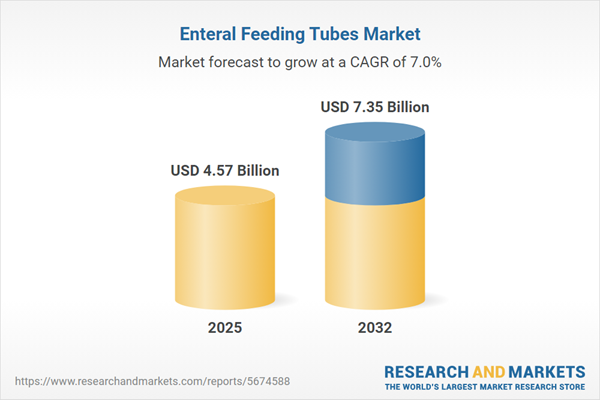Speak directly to the analyst to clarify any post sales queries you may have.
The enteral feeding tubes market is evolving rapidly, driven by clinical demand for safe, patient-centered nutrition delivery and advancements in digital integration. Modern solutions are designed to meet the rigorous needs across acute, chronic, and home-based care settings, requiring manufacturers and stakeholders to adapt with resilient, innovative strategies.
Market Snapshot: Enteral Feeding Tubes Market Size and Growth
The enteral feeding tubes market grew from USD 4.28 billion in 2024 to USD 4.57 billion in 2025. It is projected to advance at a CAGR of 6.99%, reaching USD 7.35 billion by 2032. This robust expansion is underpinned by the rising prevalence of cases requiring nutrition intervention, continuous improvement in clinical protocols, and an expanding focus on home healthcare. Steady adoption across global regions is further supported by growing collaboration between device manufacturers, clinicians, and regulatory agencies, aiming for improved patient outcomes and streamlined transitions of care.
Scope & Segmentation of the Enteral Feeding Tubes Market
- Product Type: Gastrostomy tubes (including percutaneous endoscopic, radiologically inserted, and surgical), jejunostomy tubes, nasogastric tubes
- End User: Ambulatory centers, home care, hospitals, long-term care facilities
- Tube Material: Polyurethane, polyvinyl chloride, silicone
- Distribution Channel: Direct sales, hospital pharmacy, online pharmacy, retail pharmacy
- Feeding Method: Gravity feeding, pump feeding
- Age Group: Adults, geriatrics, pediatrics
- Regional Coverage: North America (United States, Canada, Mexico), Latin America (Brazil, Argentina, Chile, Colombia, Peru), Europe (United Kingdom, Germany, France, Russia, Italy, Spain, Netherlands, Sweden, Poland, Switzerland), Middle East (United Arab Emirates, Saudi Arabia, Qatar, Turkey, Israel), Africa (South Africa, Nigeria, Egypt, Kenya), and Asia-Pacific (China, India, Japan, Australia, South Korea, Indonesia, Thailand, Malaysia, Singapore, Taiwan)
- Key Companies Covered: Fresenius Kabi AG, B. Braun Melsungen AG, Cardinal Health, Inc., Medtronic plc, Becton Dickinson and Company, Cook Medical LLC, Nipro Corporation, Teleflex Incorporated, Avanos Medical, Inc., ICU Medical, Inc.
Key Takeaways for Senior Decision-Makers
- Industry dynamics are shaped by a combination of patient safety imperatives, demand for remote care, and product customization aimed at diverse clinical pathways.
- Growth is closely linked to advancing biocompatible materials and real-time sensor technologies, which facilitate safer use and enhance patient experience.
- The market is witnessing cross-sector collaboration, accelerating innovation and rapid iteration of both device design and digital support capabilities.
- Stakeholders across the value chain are intensifying efforts to optimize cost structures, manage risk from supply interruptions, and align with evolving regulatory frameworks.
- Changing demographics and healthcare decentralization are prompting new distribution and support strategies, with a stronger shift toward supporting at-home administration.
Tariff Impact on Enteral Feeding Tubes Market
Recent tariffs on import of select medical devices, including enteral feeding tubes in the United States, have increased supply chain and cost complexities. Procurement teams are actively exploring local sourcing, alternative materials, and new supplier partnerships to offset price pressures and maintain critical supply continuity. Companies are prioritizing regulatory harmonization, enhancing their agility in adapting to global policy changes and preserving market access across key regions. Strategic relationships with domestic manufacturers and trade compliance providers are becoming central to supply resilience and sustained market leadership.
Methodology & Data Sources
This report utilizes a rigorous methodology, integrating insights from in-depth interviews with clinical experts, procurement managers, and product leaders, as well as a comprehensive review of regulatory documents, industry whitepapers, and healthcare statistics. Quantitative insights are validated through cross-verification, ensuring robust, actionable conclusions for stakeholders in the enteral feeding tubes market.
Why This Report Matters
- Enables strategic planning by providing an in-depth outlook on segmentation, regional trends, and emerging buying criteria for enteral feeding tubes.
- Supports risk mitigation and supply chain optimization, helping decision-makers benchmark innovation, resilience strategies, and competitive positioning globally.
- Empowers leadership teams to align R&D and market expansion with stakeholder needs and regulatory trajectories within a rapidly changing sector.
Conclusion
The enteral feeding tubes market is defined by its response to evolving patient needs, regulatory complexity, and technology-driven transformation. Stakeholders ready to embrace innovation, collaboration, and operational agility will secure lasting value as this market progresses.
Additional Product Information:
- Purchase of this report includes 1 year online access with quarterly updates.
- This report can be updated on request. Please contact our Customer Experience team using the Ask a Question widget on our website.
Table of Contents
3. Executive Summary
4. Market Overview
7. Cumulative Impact of Artificial Intelligence 2025
Companies Mentioned
The companies profiled in this Enteral Feeding Tubes market report include:- Fresenius Kabi AG
- B. Braun Melsungen AG
- Cardinal Health, Inc.
- Medtronic plc
- Becton Dickinson and Company
- Cook Medical LLC
- Nipro Corporation
- Teleflex Incorporated
- Avanos Medical, Inc.
- ICU Medical, Inc.
Table Information
| Report Attribute | Details |
|---|---|
| No. of Pages | 199 |
| Published | October 2025 |
| Forecast Period | 2025 - 2032 |
| Estimated Market Value ( USD | $ 4.57 Billion |
| Forecasted Market Value ( USD | $ 7.35 Billion |
| Compound Annual Growth Rate | 6.9% |
| Regions Covered | Global |
| No. of Companies Mentioned | 11 |









